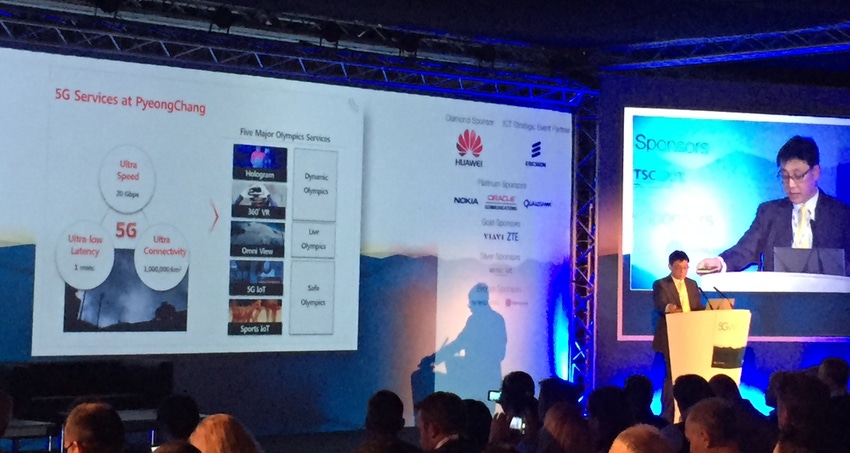Operators NTT and KT have given an update on their 5G strategies, with each giving an insight into their current progress and targeted milestones along the way.
June 29, 2016

Operators NTT and KT have given an update on their 5G strategies, with each giving an insight into their current progress and targeted milestones along the way.
Speaking at 5G World, KT SVP of Network Technology, Young Sik Kim, explained how the evolution in consumer electronics is forcing the operator to think about 5G as more than just developing more speed for device connectivity.
“As mobile has evolved through generations and devices, services are always changing,” said Kim. “In 5 years’ time, what sort of service or device evolution will happen? Generally speaking, handset numbers are staying the same, but connected TVs, consumer electronics and IoT is growing significantly, and that is a big challenge.”
Citing IoT, Kim said 5G challenges for machine type communications vary wildly in terms of speed, capacity and latency requirements. Recalling recent data from IDC, he said there will be more than 200 billion IoT connections that 5G will have to deal with by 2020. He then clarified the hybrid technology approach KT is taking to ensure coverage, speed and latency the explosion in consideration of the forthcoming data “big bang”, in which it anticipates a data growth rate of more than 1000 x compared to recent years.
“We are preparing fundamental enabling technologies like LTE-A Pro, Giga LTE, and new wifi protocols capable of delivering more than 1 Gbps,” Kim said. “We are working hard on LTE/wifi link aggregation, LTE-U and many others to help us get there.”
KT, NTT DoCoMo and China Mobile are all looking at running trial or live services in upcoming Olympic Games events: Korea 2018, Japan 2020 and China 2022. The latter two will be expecting to run fully deployed commercial services, but KT’s PyeongChang 2018 project is scheduled to be the first global event utilising 5G specifications from the 5G-PPP, which is expected to unveil its confirmed spec by the start of 2018.
8K UHD Mobile Hologram Services, UHD live streaming, 360 degree virtual reality and what Kim referred to as “Omni View” live sports broadcasting are all core elements of KT’s services strategy for PyeongChang 2018 Winter Olympic Games. With all of this in mind, Kim said KT wants to use 5G to deliver a dynamic, truly live and completely safe global event.
Kim also discussed KT’s 5G “Innovation Belt”, which includes open labs and trial areas covering Gangnam in Korea, running down to a site near the PyeongChang site for the Winter Olympics. The aim for PyeongChang, according to Kim, is to utilise superfast fibre broadband infrastructure with 5G wireless connectivity to deliver a superfast converged platform.
Meanwhile, NTT DoCoMo’s VP of 5G, Takehiro Nakamura has said the Japanese operator will be planning its first 5G roll out for 2020; but has stipulated that at least ten years’ worth of evolution and tight integration with LTE will be required to fully optimise the technology. Stating unlicensed bands will play a big part of the deployment of 5G, Nakamura did suggest the potential of the fifth generation of wireless networking is reliant upon the licensing of new higher frequency bands.
Between 2017 and 2019 NTT is looking to conduct system trials in Tokyo ahead of the 2020 Olympic Games, while early commercial system deployments are likely to begin in parts during 2017, with a full commercial launch scheduled for mid-2020.
“We need to find candidate spectrum bands to develop our 5G system,” said Nakamura. “Some device vendors have said in order to launch 5G in 2020, spectrum has to be decided this year so they can start developing the right devices. At the moment, spectrum availability in Japan is not great, and that is for both sub 6 GHz and above 6 GHz – we hope this becomes more available as we approach 2020, and this will require a lot of collaboration.
“European countries are more aggressively pursuing the necessary spectrum bands, and Asian operators need to do the same.”
Nakamura went into detail on some field trials it is conducting in narrowband spectrum fields, citing an experimental small cell project involving connected parasols in pedestrianised areas, which generated a combined download speed of 1.3 Gbps; while other trials above the 28 GHz frequency saw moving vehicles recording speeds averaging between 2 and 3 Gbps.
Trials in 73 GHz frequencies saw non-line of sight connectivity of more than 500 Mbps at its lowest point, while direct line of sight connectivity using beamforming provided roughly 2.5 Gbps.
In an interesting element of his presentation, Nakamura also demonstrated visualised beamforming connectivity, showing how moving targets can be hit with a direct line of connectivity. Beamforming has been touted as one of the most important factors for any successful 5G deployment, and the technology appears to be in place based on images from its trials, see below.
The overarching theme from this early stage of 5G World 2016 suggests that, as expected, operators from the Far East are closer to realising a commercially viable version of 5G than anyone else in the world, and that we could be seeing live, working versions of 5G in as little as 18 months from now.
About the Author(s)
You May Also Like








.png?width=300&auto=webp&quality=80&disable=upscale)


_1.jpg?width=300&auto=webp&quality=80&disable=upscale)


.png?width=800&auto=webp&quality=80&disable=upscale)